Abstract
Eight individual antigens were detected in soluble antigen preparations from Mycobacterium leprae bacilli by using pools of serum samples from lepromatous leprosy patients as antibody reagents in crossed immunoelectrophoresis. Two of these antigens were analyzed further. Antgent no. 1 gave an elution pattern on Sephadex G-200 corresponding to a molecular weight of 285,000. This antigen was also present in three slow-growing and eight fast-growing mycobacterial species. There was a reaction of complete identity in immunological tests using lepromatous serum pools as well as with rabbit antisera raised against M. leprae and M. smegmatis. Antigen no. 21 of M. leprae showed antigenic heterogeneity when compared with other species. Three types of antigenic determinants were detected; one, called 21A, was shared by all mycobacteria, another, called 21B, was limited to antigen no. 21 of M. leprae; a third, called 21C, was present in all mycobacteria except the leprosy bacillus. This submolecular heterogeneity may indicate a separate taxonomic position of M. leprae among the mycobacteria.
Full text
PDF
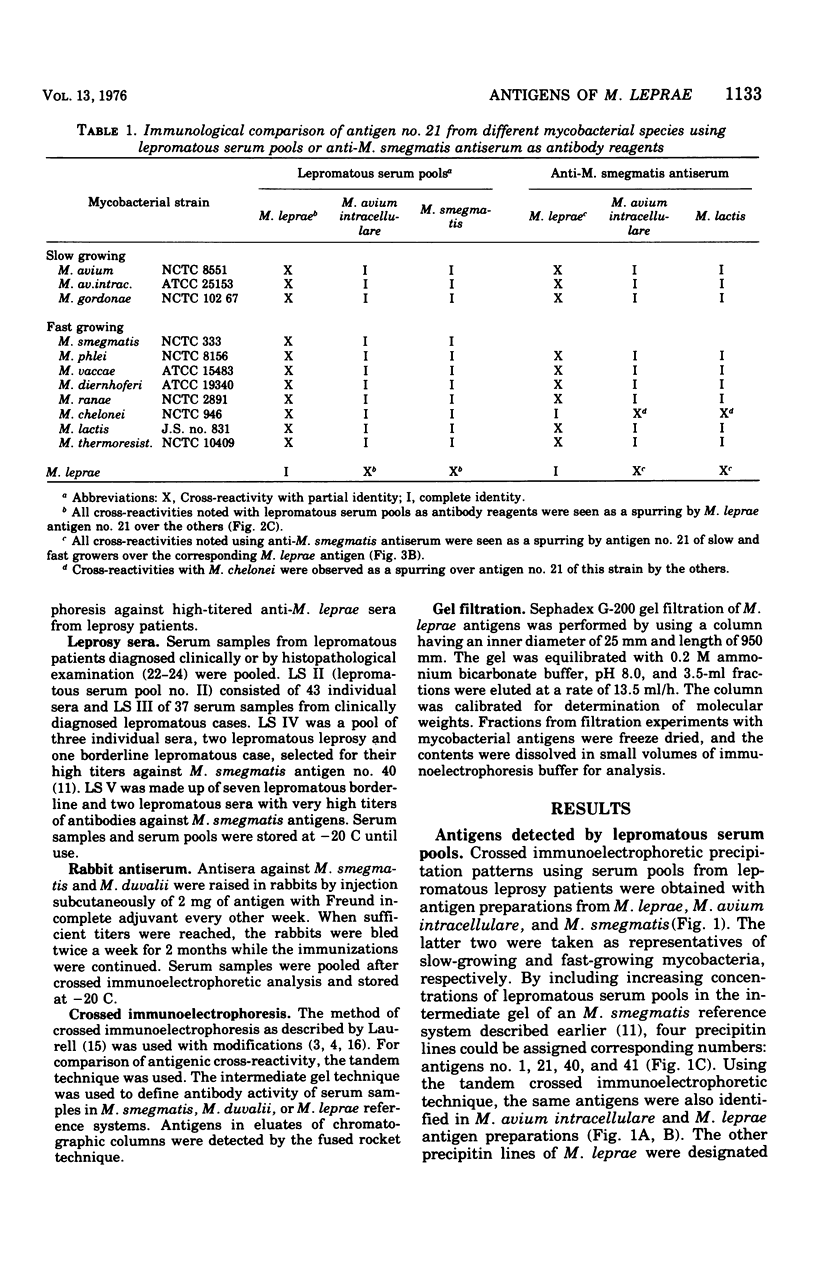
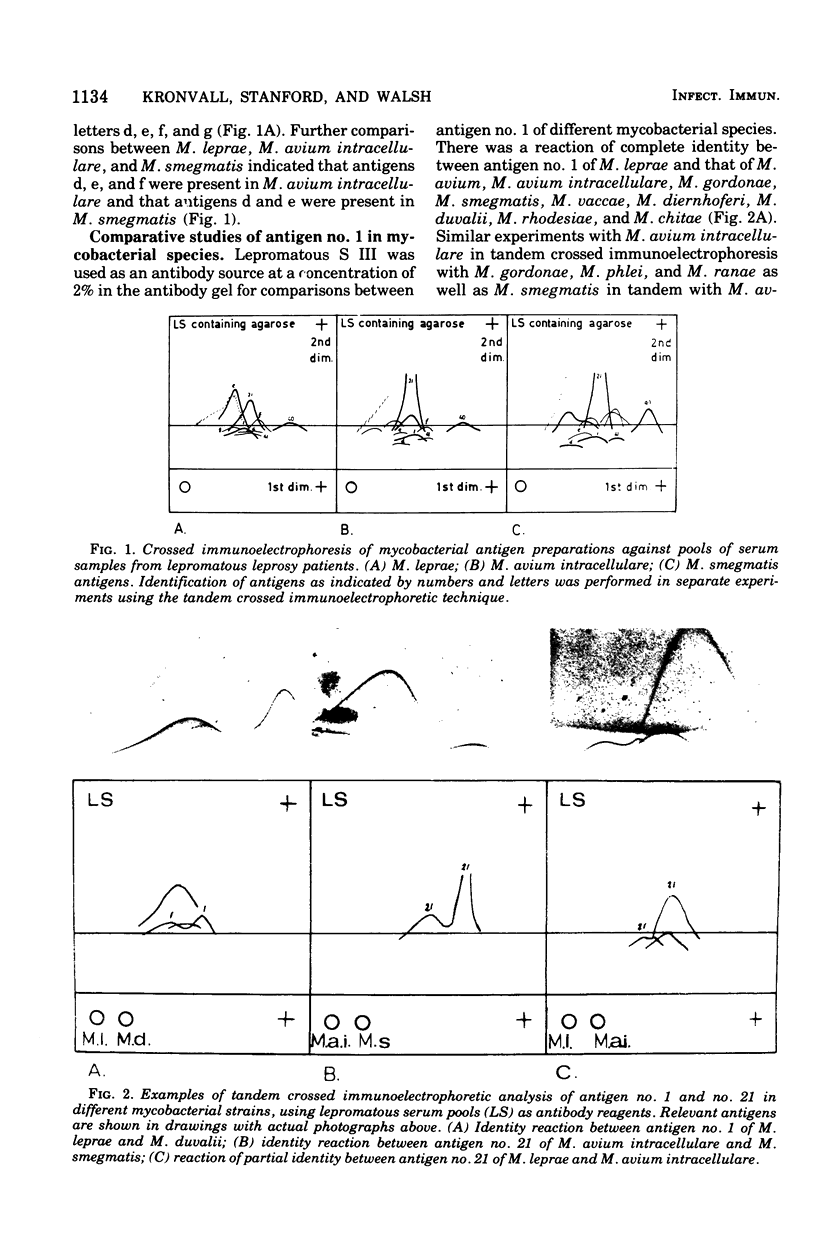

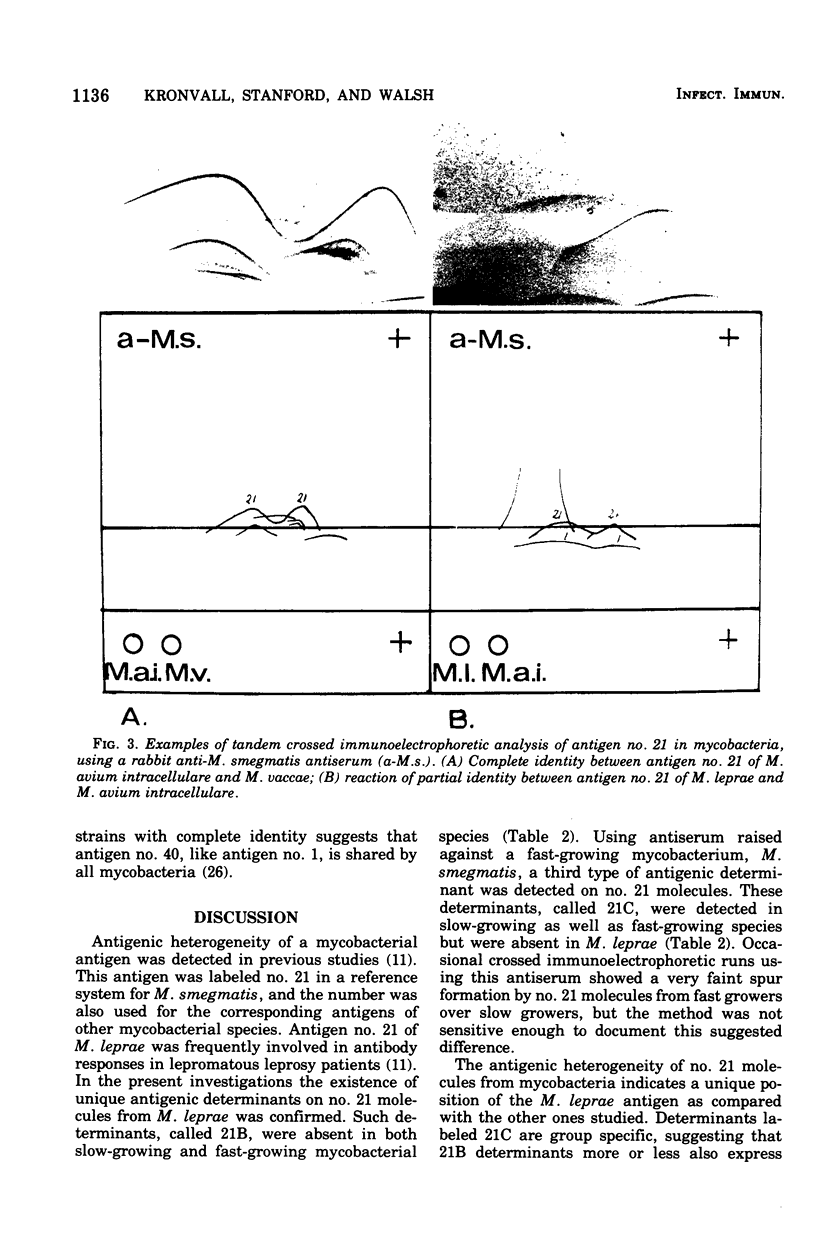
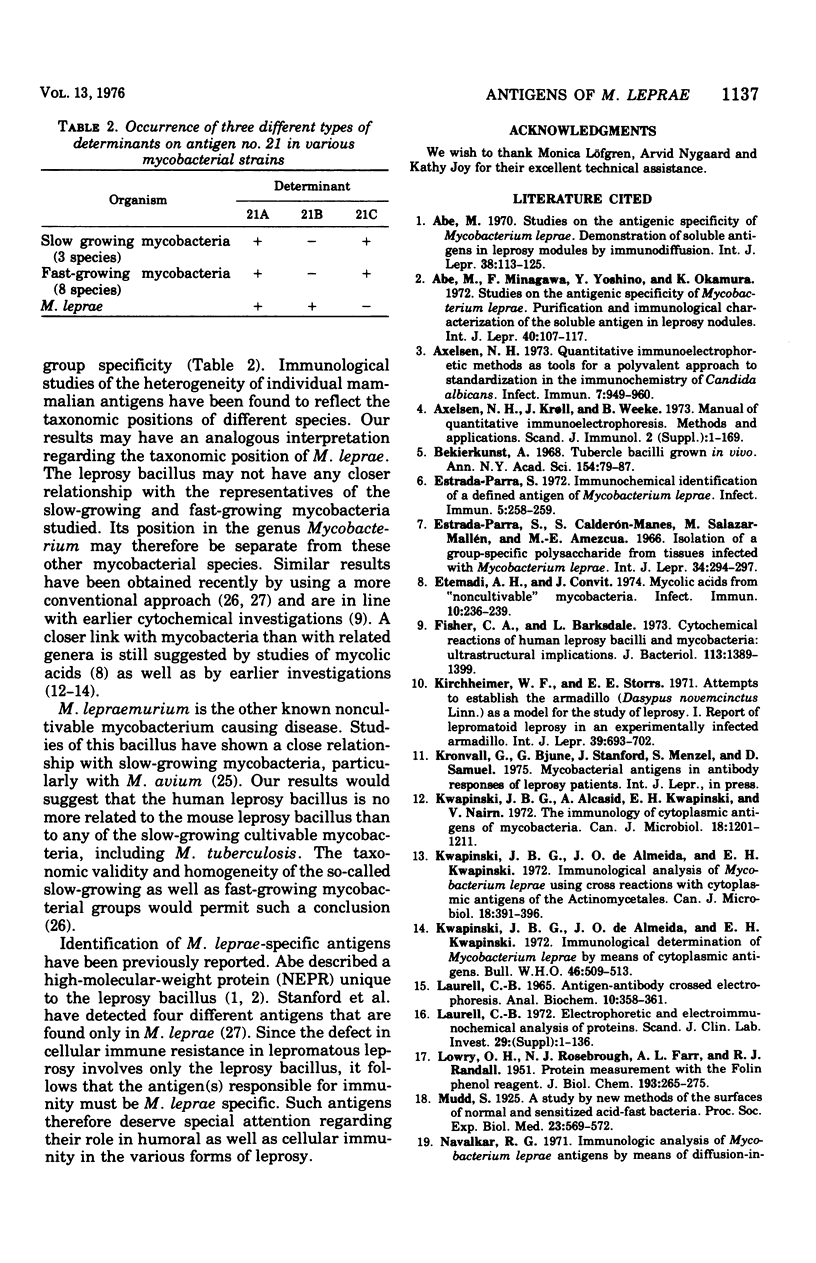
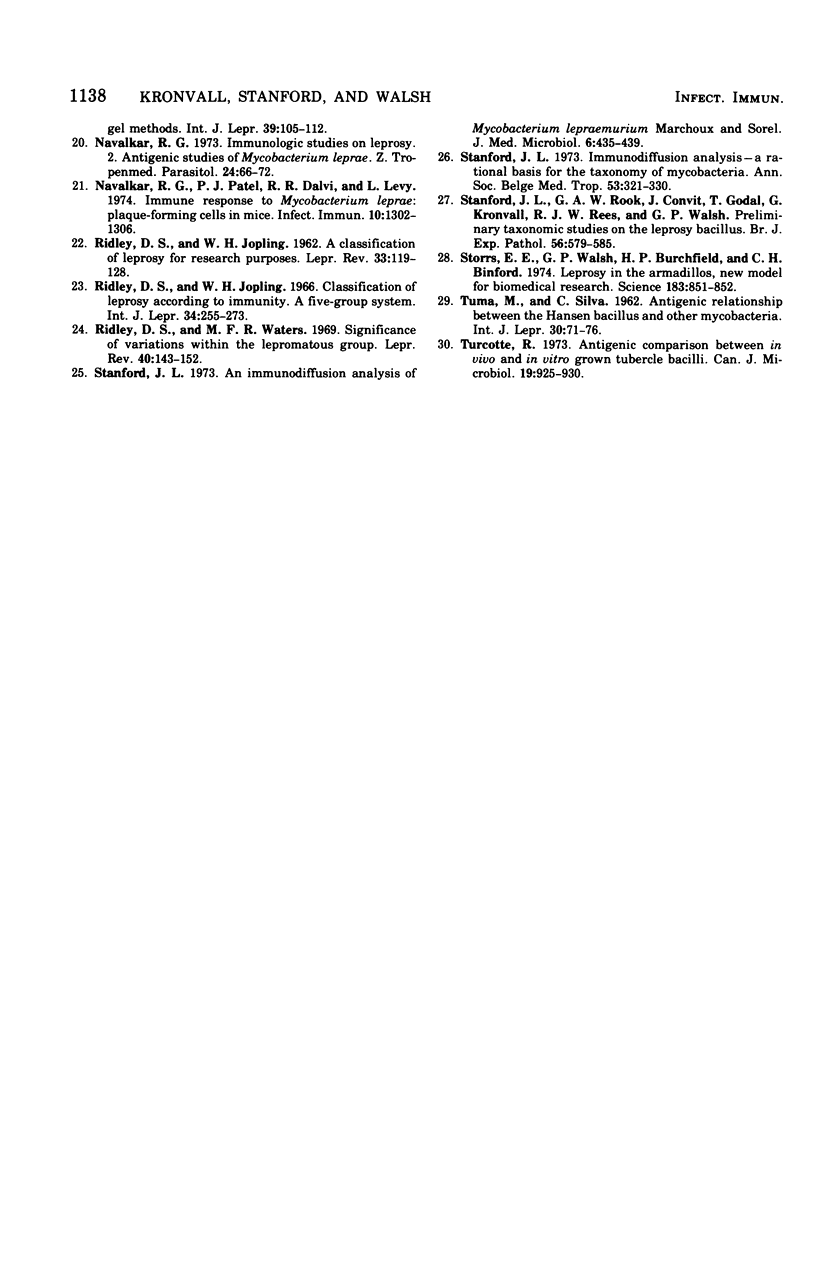
Images in this article
Selected References
These references are in PubMed. This may not be the complete list of references from this article.
- Abe M., Minagawa F., Yoshino Y., Okamura K. Studies on the antigenic specificity of Mycobacterium leprae. II. Purification and immunological characterization of the soluble antigen in leprosy nodules. Int J Lepr Other Mycobact Dis. 1972 Apr-Jun;40(2):107–117. [PubMed] [Google Scholar]
- Abe M. Studies on the antigenic specificity of Mycobacterium leprae. I. Demonstration of soluble antigens in leprosy nodules by immunodiffusion. Int J Lepr Other Mycobact Dis. 1970 Apr-Jun;38(2):113–125. [PubMed] [Google Scholar]
- Aronsen K. F., Ekelund G., Kindmark C. O., Laurell C. B. Sequential changes of plasma proteins after surgical trauma. Scand J Clin Lab Invest Suppl. 1972;124:127–136. doi: 10.3109/00365517209102760. [DOI] [PubMed] [Google Scholar]
- Axelsen N. H. Quantitative immunoelectrophoretic methods as tools for a polyvalent approach to standardization in the immunochemistry of Candida albicans. Infect Immun. 1973 Jun;7(6):949–960. doi: 10.1128/iai.7.6.949-960.1973. [DOI] [PMC free article] [PubMed] [Google Scholar]
- Bekierkunst A. Biology of the mycobacterioses. Tubercle bacilli grown in vivo. Ann N Y Acad Sci. 1968 Sep 5;154(1):79–87. doi: 10.1111/j.1749-6632.1968.tb16697.x. [DOI] [PubMed] [Google Scholar]
- Estrada-Parra S., Calderón-Manes S., Salazar-Mallén M., Amezcua M. E. Isolation of a group-specific polysaccharide from tissues infected with Mycobacterium leprae. Int J Lepr Other Mycobact Dis. 1966 Jul-Sep;34(3):294–297. [PubMed] [Google Scholar]
- Estrada-Parra S. Immunochemical identification of a defined antigen of Mycobacterium leprae. Infect Immun. 1972 Feb;5(2):258–259. doi: 10.1128/iai.5.2.258-259.1972. [DOI] [PMC free article] [PubMed] [Google Scholar]
- Etemadi A. H., Convit J. Mycolic acids from "noncultivable" mycobacteria. Infect Immun. 1974 Jul;10(1):236–239. doi: 10.1128/iai.10.1.236-239.1974. [DOI] [PMC free article] [PubMed] [Google Scholar]
- Fisher C. A., Barksdale L. Cytochemical reactions of human leprosy bacilli and mycobacteria: ultrastructural implications. J Bacteriol. 1973 Mar;113(3):1389–1399. doi: 10.1128/jb.113.3.1389-1399.1973. [DOI] [PMC free article] [PubMed] [Google Scholar]
- Kirchheimer W. F., Storrs E. E. Attempts to establish the armadillo (Dasypus novemcinctus Linn.) as a model for the study of leprosy. I. Report of lepromatoid leprosy in an experimentally infected armadillo. Int J Lepr Other Mycobact Dis. 1971 Jul-Sep;39(3):693–702. [PubMed] [Google Scholar]
- Koch C., Nielsen H. E. Effect of anti light-chain antibodies on rat leukocytes in vitro. Scand J Immunol. 1973;2(1):1–8. doi: 10.1111/j.1365-3083.1973.tb02009.x. [DOI] [PubMed] [Google Scholar]
- Kwapinski JB De Almeid, Kwapinski E. H. Immunological analysis of Mycobacterium leprae using cross-reactions with cytoplasmic antigens of the actinomycetales. Can J Microbiol. 1972 Apr;18(4):391–396. [PubMed] [Google Scholar]
- Kwapinski J. B., Alcasid A., Kwapinski E. H., Nairn V. The immunology of cytoplasmic antigens of mycobacteria. Can J Microbiol. 1972 Aug;18(8):1201–1211. doi: 10.1139/m72-188. [DOI] [PubMed] [Google Scholar]
- Kwapinski J. B., de Almeida J. O., Kwapinski E. H. Immunological determination of Mycobacterium leprae by means of cytoplasmic antigens. Bull World Health Organ. 1972;46(4):509–513. [PMC free article] [PubMed] [Google Scholar]
- LAURELL C. B. ANTIGEN-ANTIBODY CROSSED ELECTROPHORESIS. Anal Biochem. 1965 Feb;10:358–361. doi: 10.1016/0003-2697(65)90278-2. [DOI] [PubMed] [Google Scholar]
- LOWRY O. H., ROSEBROUGH N. J., FARR A. L., RANDALL R. J. Protein measurement with the Folin phenol reagent. J Biol Chem. 1951 Nov;193(1):265–275. [PubMed] [Google Scholar]
- Navalkar R. G. Immunologic studies on leprosy. 2. Antigenic studies of Mycobacterium leprae. Z Tropenmed Parasitol. 1973 Dec;24(Suppl):66–72. [PubMed] [Google Scholar]
- Navalkar R. G., Patel P. J., Dalvi R. R., Levy L. Immune response to Mycobacterium leprae: plaque-forming cells in mice. Infect Immun. 1974 Dec;10(6):1302–1306. doi: 10.1128/iai.10.6.1302-1306.1974. [DOI] [PMC free article] [PubMed] [Google Scholar]
- RIDLEY D. S., JOPLING W. H. A classification of leprosy for research purposes. Lepr Rev. 1962 Apr;33:119–128. doi: 10.5935/0305-7518.19620014. [DOI] [PubMed] [Google Scholar]
- Ridley D. S., Jopling W. H. Classification of leprosy according to immunity. A five-group system. Int J Lepr Other Mycobact Dis. 1966 Jul-Sep;34(3):255–273. [PubMed] [Google Scholar]
- Ridley D. S., Waters M. F. Significance of variations within the lepromatous group. Lepr Rev. 1969 Jul;40(3):143–152. doi: 10.5935/0305-7518.19690026. [DOI] [PubMed] [Google Scholar]
- Stanford J. L. An immunodiffusion analysis of Mycobacterium lepraemurium Marchoux and Sorel. J Med Microbiol. 1973 Nov;6(4):435–439. doi: 10.1099/00222615-6-4-435. [DOI] [PubMed] [Google Scholar]
- Stanford J. L. Immunodiffusion analysis--a rational basis for the taxonomy of mycobacteria. Ann Soc Belg Med Trop. 1973;53(4):321–330. [PubMed] [Google Scholar]
- Storrs E. E., Walsh G. P., Burchfield H. P., Binford C. H. Leprosy in the armadillo: new model for biomedical research. Science. 1974 Mar 1;183(4127):851–852. doi: 10.1126/science.183.4127.851. [DOI] [PubMed] [Google Scholar]
- TUMA M., SILVA C. Antigenic relationship between the Hansen bacillus and other mycobacteria. Int J Lepr. 1962 Jan-Mar;30:71–76. [PubMed] [Google Scholar]
- Turcotte R. Antigenic comparison between in vivo and in vitro grown tubercle bacilli. Can J Microbiol. 1973 Aug;19(8):925–930. doi: 10.1139/m73-148. [DOI] [PubMed] [Google Scholar]




